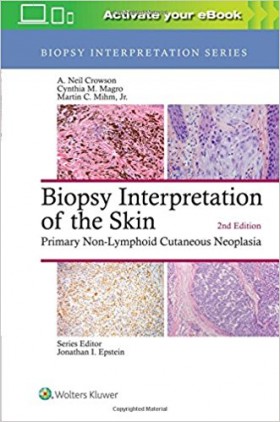Cover
Half Titlepage
Title Page
Copyright
Additional Contributor
Preface
Contents
Chapter 1. How and When to Biopsy the Skin
Preparation for the Biopsy
Anesthesia
Punch Biopsy
Shave Biopsy
Snip Biopsy
Excisional Biopsy
Curette Biopsy
Wedge Biopsies
Biopsies of the Scalp
Biopsies of the Lip
Biopsies of the Genitalia
Postoperative Care
Complications
Nail Biopsy
References
Chapter 2. Benign Melanocytic Proliferations and Precursor Lesions to Melanoma
Benign Melanocytic Lesions Confined to the Epidermis
Common Acquired Nevus and Other Benign-Acquired Nevi
Congenital Nevus
Recurrent Melanocytic Nevus
Dermal Dendritic Melanocytic Proliferations
Nevi of Special Anatomic Sites
Spitz Nevus
Combined Nevus
Deep Penetrating Nevus and the Borderline Tumor Arising in the Deep Penetrating Nevus
Plexiform Spindle Cell Nevus
Dysplastic Nevus and de Novo Intraepidermal Epithelioid Melanocytic Dysplasia
References
Chapter 3. Melanoma: Classic Subtypes
Specific Subtypes of Malignant Melanoma
Vertical Growth Phase of Melanoma
Metastatic Melanoma
Melanoma in Childhood
References
Chapter 4. Histologic and Phenotypic Variants of Melanoma and of the Borderline Melanocytic Tumor
Desmoplastic Melanoma
Nevoid Melanoma
Malignant Blue Nevus
Unusual Cytomorphologic and Phenotypic Variants of Melanoma (Metaplastic, Balloon, Signet Ring, Myxoid,
Small Cell, and Rhabdoid Melanoma)
CD34 Expression in Melanoma
Epithelial Marker Expression
Fibrohistiocytic Differentiation
Smooth Muscle Differentiation
Absence of Melanocyte Differentiation Markers
Melanocytic Tumors of Undetermined Malignant Potential/Borderline Melanocytic Proliferations with a Focus
on the Nevoid Borderline Tumor and Pigmented Epithelioid Melanocytoma
Minimal-Deviation Melanoma/Nevoid Borderline Melanocytic Tumor
Pigmented Epithelioid Melanocytoma and Animal-Type Melanoma
References
Chapter 5. Prognosticators of Melanoma, The Melanoma Report, and The Sentinel Lymph Node
Prognostication Including Microstaging of Melanoma
Vertical Growth Phase Melanoma
Conclusion
Acknowledgment
References
Chapter 6. Basal Cell Carcinoma: Clinical Features, Histology, and Biology
Basal Cell Carcinoma
Nevoid Basal Cell Carcinoma (Basal Cell Nevus) Syndrome
Undifferentiated Basal Cell Carcinomas
Differentiated Basal Cell Carcinomas
Pathogenesis
Conclusion
Acknowledgments
References
Chapter 7. Squamous Cell Carcinoma and Its Precursors
Squamous Cell Carcinoma Arising in Actinic Keratoses
Spontaneously Regressing Well-Differentiated Squamous Cell Carcinoma/Keratoacanthoma
Verrucous Carcinoma
Other Forms of Intraepidermal Squamous Dysplasia Related to Human Papillomavirus Infection
Spindle Cell Squamous Cell Carcinoma
Acantholytic Squamous Cell Carcinoma
Lymphoepithelioma-Like Carcinoma of the Skin
Squamous Cell Carcinoma Exhibiting an Intraepidermal Epithelioma Growth Pattern
Bowen’s Disease
Adenosquamous Carcinoma
Squamous Cell Carcinoma Arising in Association with Proliferating Pilar Tumor/Cysts and Epidermal Cysts
De Novo Squamous Cell Carcinoma
Basaloid Squamous Cell Carcinoma
Squamous Cell Carcinoma Arising in Association with Radiation and in Disorders with Chronic Inflammation
Squamous Cell Carcinoma in the Setting of Solid Organ Transplantation
Clear Cell Variant of Squamous Cell Carcinoma
Follicular Squamous Cell Carcinoma
Other Indeterminate-Risk Tumors
Prognostic Factors
Acknowledgment
References
Chapter 8. Benign Adnexal Neoplasms
Benign Neoplasms Derived from the Eccrine Apparatus
Papillary Eccrine Adenoma
Apocrine Neoplasms
Mixed Lineage Sweat Gland Neoplasms
Benign Tumors of the Pilosebaceous Apparatus
Benign Tumors of the Hair Follicle Apparatus
Tumors of the Germinative Follicular Anlage
Pilosebaceous Proliferations with Mesenchymal Elements
Neoplasms with Follicular-Based Mesenchymal Differentiation
Adnexal Nevus (Hair Follicle Nevus, Eccrine Nevus, and Porokeratotic Adnexal Ostial Nevus)
Benign Tumors of the Nail Apparatus
References
Chapter 9. Malignant Adnexal Neoplasms
Malignant Tumors of the Pilosebaceous Apparatus, their Mimics, and Precursor Lesions
Malignant Neoplasms of the Folliculosebaceous Apparatus
Malignant Neoplasms of the Sweat Gland Apparatus and their Mimics
References
Chapter 10. Soft Tissue Neoplasms of the Skin and Superficial Subcutis
Tumors of Fibrohistiocytic Derivation
Hamartomatous Fibrous Lesions
Tumors of Fibrohistiocytic Origin
Myxomatous Neoplasms
Tumors of Fat, Muscle, Cartilage, and Bone
Smooth Muscle Tumors
Tumors of Skeletal Muscle Origin
Tumors of Cartilage and Mineral/Bone Derivation
Neural and Neuroendocrine Tumors
Vascular Lesions
Tumors of Undifferentiated Mesenchymal Origin and/or of Uncertain Histogenesis
References
Chapter 11. Medicolegal Aspects of Neoplastic Dermatology
Malpractice, Negligence, and the Burden of Proof
Nature of Error in Dermatopathologic Practice
Strategies for the Avoidance of Potentially Litigious Diagnostic Errors
When You Detect a Possible Error or Receive a Statement of Claim
Conclusion
Acknowledgments
References
Interactive Question Bank
Index


